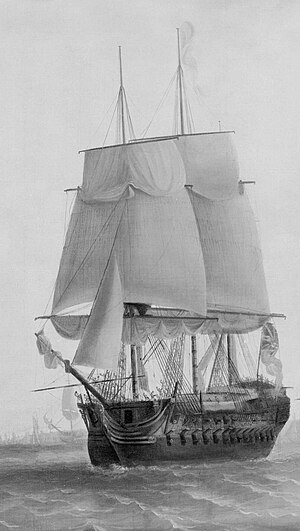 HMS Carnatic, the first of the Carnatic-class seventy-fours, built to the exact lines of Courageux
| |
| History | |
|---|---|
| Name | Courageux |
| Builder | Brest |
| Launched | 11 October 1753 |
| Captured | 13 August 1761, by Royal Navy |
| Name | Courageux |
| Acquired | 13 August 1761 |
| Fate | Wrecked off Gibraltar, 18 December 1796 |
| General characteristics [1][2] | |
| Class and type | 74-gun third-rate ship of the line |
| Tons burthen | 1,72130⁄94 bm |
| Length | 172 feet 3 inches (52.5 m) (gundeck) |
| Beam | 48 ft 3⁄4 in (14.6 m) |
| Depth of hold | 20 ft 10+1⁄2 in (6.4 m) |
| Sail plan | Full-rigged ship |
| Armament |
|
Courageux was a 74-gun ship of the line of the French Navy, launched in 1753. She was captured by the Royal Navy in 1761 and taken into service as HMS Courageux. In 1778 she joined the Channel Fleet, and she was later part of the squadron commanded by Commodore Charles Fielding that controversially captured a Dutch convoy on 31 December 1779, in what became known as the Affair of Fielding and Bylandt. On 4 January 1781, Courageux recaptured Minerva in a close-range action west of Ushant that lasted more than an hour. That April, Courageux joined the convoy under George Darby which successfully relieved the Great Siege of Gibraltar.
At the start of the French Revolutionary Wars, Courageux took part in the blockade and subsequent occupation of Toulon in 1793. That September, she was sent with a squadron under Robert Linzee to support an insurrection in Corsica and took part in an unsuccessful attack on San Fiorenzo. When Toulon was evacuated, Courageux was in a state of disrepair and was forced to warp out of her mooring without a rudder, but was able to complete repairs while rescuing allied troops from the waterfront. At the Battle of Genoa in March 1795, she was instrumental in the capture of the French ships Ça Ira and Censeur, but at the subsequent Battle of the Hyères Islands, she was so slow getting into the action that, by the time she arrived, the order had been given to disengage.
In December 1796, Courageux was with the Mediterranean Fleet, anchored in the bay of Gibraltar, when a great storm tore her from her mooring and drove her onto the rocks of the Barbary coast. Of the 593 officers and men who were on board, only 129 escaped: five by means of a launch, and the rest by clambering along the fallen mainmast to the shore.